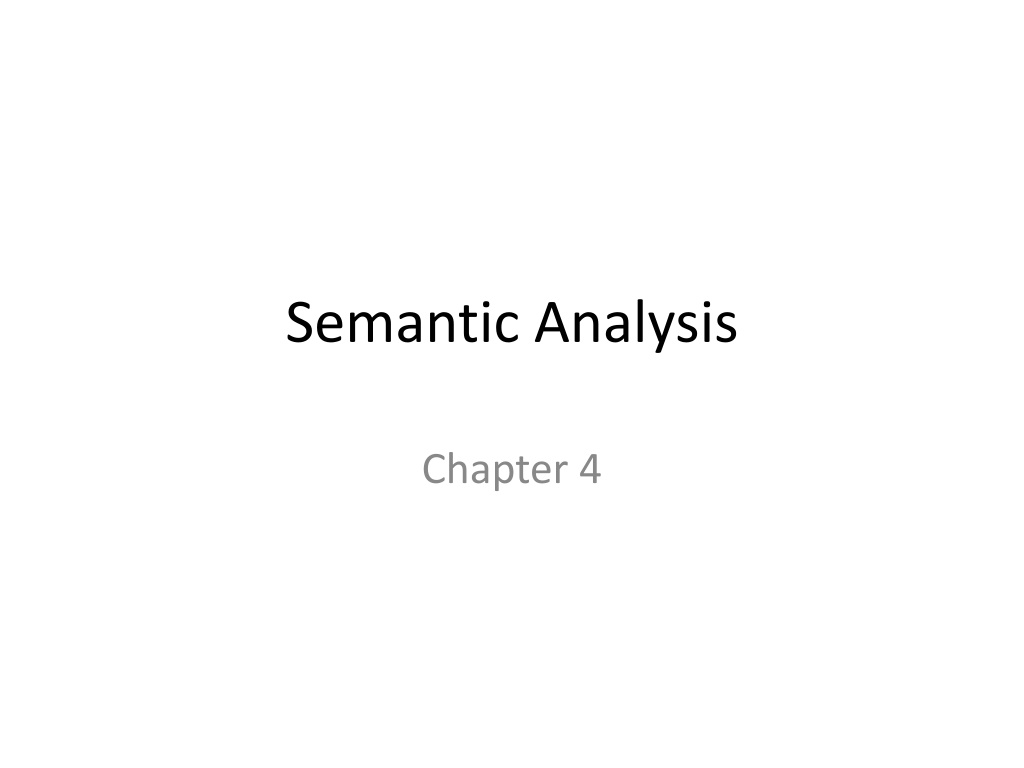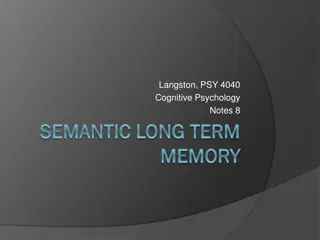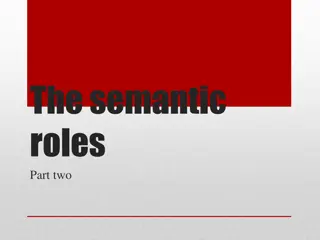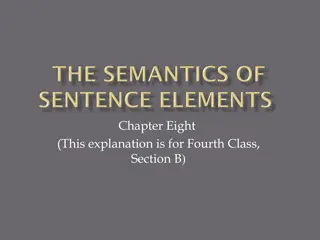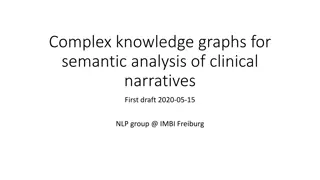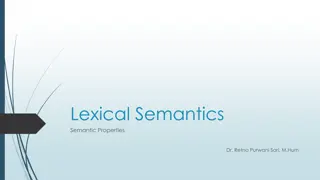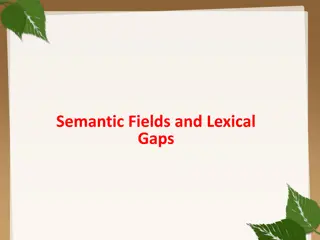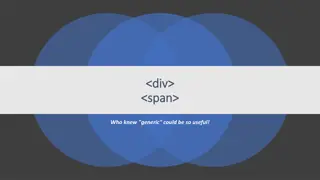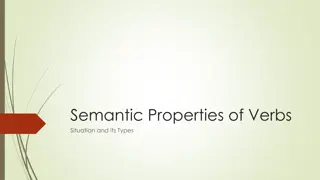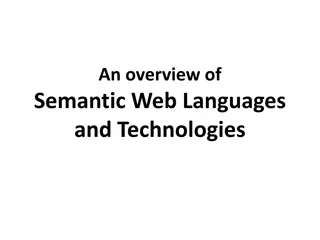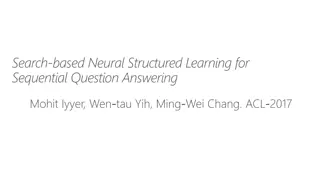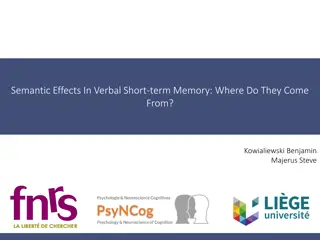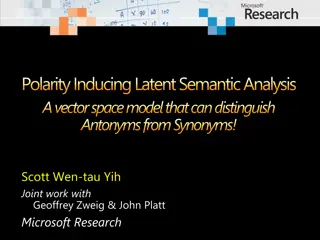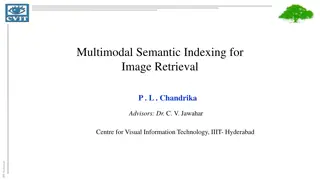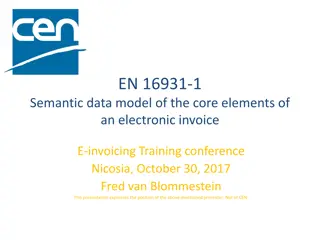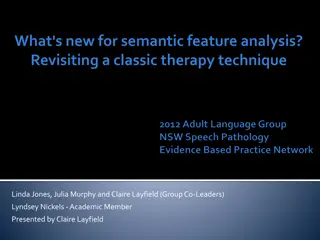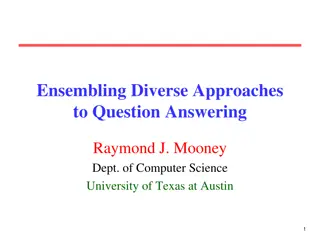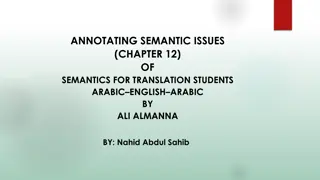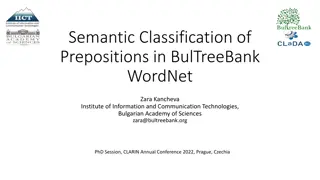Semantic Analysis
Semantic analysis in compiler design involves enforcing static semantic rules and generating intermediate code. Learn about the role of semantic analysis, attribute grammars, and how they define the semantics of input programs.
Download Presentation

Please find below an Image/Link to download the presentation.
The content on the website is provided AS IS for your information and personal use only. It may not be sold, licensed, or shared on other websites without obtaining consent from the author.If you encounter any issues during the download, it is possible that the publisher has removed the file from their server.
You are allowed to download the files provided on this website for personal or commercial use, subject to the condition that they are used lawfully. All files are the property of their respective owners.
The content on the website is provided AS IS for your information and personal use only. It may not be sold, licensed, or shared on other websites without obtaining consent from the author.
E N D
Presentation Transcript
Semantic Analysis Chapter 4
Role of Semantic Analysis Following parsing, the next two phases of the "typical" compiler are semantic analysis (intermediate) code generation The principal job of the semantic analyzer is to enforce static semantic rules constructs a syntax tree (usually first) information gathered is needed by the code generator
Role of Semantic Analysis There is considerable variety in the extent to which parsing, semantic analysis, and intermediate code generation are interleaved A common approach interleaves construction of a syntax tree with parsing (no explicit parse tree), and then follows with separate, sequential phases for semantic analysis and code generation
Attribute Grammars Both semantic analysis and (intermediate) code generation can be described in terms of annotation, or "decoration" of a parse or syntax tree ATTRIBUTE GRAMMARS provide a formal framework for decorating such a tree Consider the following LR (bottom-up) grammar for arithmetic expressions made of constants, with precedence and associativity:
Attribute Grammars E E + T E E T E T T T * F T T / F T F F - F F (E) F const This says nothing about what the program MEANS
Attribute Grammars We can turn this into an attribute grammar as follows (similar to Figure 4.1): E E + T E1.val = Sum(E2.val,T.val) E E T E1.val = Diff(E2.val,T.val) E T E.val = T.val T T * F T1.val = Prod(T2.val,F.val) T T / F T1.val = Div(T2.val,F.val) T F T.val = F.val F - F F1.val = Prod(F2.val,-1) F (E) F.val = E.val F const F.val = C.val
Attribute Grammars The attribute grammar serves to define the semantics of the input program Attribute rules are best thought of as definitions, not assignments They are not necessarily meant to be evaluated at any particular time, or in any particular order, though they do define their left-hand side in terms of the right-hand side
Evaluating Attributes The process of evaluating attributes is called annotation, or DECORATION, of the parse tree When a parse tree under this grammar is fully decorated, the value of the expression will be in the val attribute of the root The code fragments for the rules are called SEMANTIC FUNCTIONS Strictly speaking, they should be cast as functions, e.g., E1.val = sum (E2.val, T.val) but often we will use the obvious E1.val = E2.val + T.val
Evaluating Attributes E E + T E E T E T T T * F T T / F T F F - F F (E) F const E1.val = E2.val + T.val E1.val = E2.val - T.val E.val = T.val T1.val = T2.val * F.val T1.val = T2.val / F.val T.val = F.val F1.val = - F2.val F.val = E.val F.val = C.val
Evaluating Attributes This is a very simple attribute grammar: Each symbol has at most one attribute the punctuation marks have no attributes These attributes are all so-called SYNTHESIZED attributes: They are calculated only from the attributes of things below them in the parse tree
Evaluating Attributes In general, we are allowed both synthesized and INHERITED attributes: Inherited attributes may depend on things above or to the side of them in the parse tree Tokens have only synthesized attributes, initialized by the scanner (name of an identifier, value of a constant, etc.). Inherited attributes of the start symbol constitute run-time parameters of the compiler
Inherited Attributes LL(1) grammar covering subtraction: Expr const Expr_Tail Expr_Tail - const Expr_Tail | For the expression 9 4 3: Expr 9 Expr_Tail - 4 Expr_Tail - 3 Expr_Tail
Inherited Attributes If we are allowed to pass attribute values not only bottom-up but also left-to-right then we can pass 9 into the Expr_Tail node for evaluation, and so on for each Expr_Tail Expr 9 Expr_Tail - 4 Expr_Tail - 3 Expr_Tail Similar to recursion when the result is accumulated as recursive calls made
Evaluating Attributes The grammar for evaluating expressions is called S-ATTRIBUTED because it uses only synthesized attributes Its ATTRIBUTE FLOW (attribute dependence graph) is purely bottom-up It is SLR(1), but not LL(1) An equivalent LL(1) grammar requires inherited attributes:
Evaluating Attributes Example Attribute grammar in Figure 4.3: E T TT TT1 + T TT2 TT1 - T TT2 TT T F FT E.v = TT.v TT.st = T.v TT1.v = TT2.v TT2.st = TT1.st + T.v TT1.v = TT2.v TT2.st = TT1.st - T.v TT.v = TT.st T.v = FT.v FT.st = F.v
Evaluating Attributes Example Attribute grammar in Figure 4.3 (continued): FT1 * F FT2 FT1.v = FT2.v FT2.st = FT1.st * F.v FT1 / F FT2 FT1.v = FT2.v FT2.st = FT1.st / F.v FT FT.v = FT.st F1 - F2 F1.v = - F2.v F ( E ) F.v = E.v F const F.v = C.v Figure 4.4 parse tree for (1+3)*2
Evaluating Attributes Example Attribute grammar in Figure 4.3: This attribute grammar is a good bit messier than the first one, but it is still L-ATTRIBUTED, which means that the attributes can be evaluated in a single left-to-right pass over the input In fact, they can be evaluated during an LL parse Each synthetic attribute of a LHS symbol (by definition of synthetic) depends only on attributes of its RHS symbols
Evaluating Attributes Example Attribute grammar in Figure 4.3: Each inherited attribute of a RHS symbol (by definition of L-attributed) depends only on inherited attributes of the LHS symbol, or synthetic or inherited attributes of symbols to its left in the RHS L-attributed grammars are the most general class of attribute grammars that can be evaluated during an LL parse
Evaluating Attributes There are certain tasks, such as generation of code for short-circuit Boolean expression evaluation, that are easiest to express with non-L-attributed attribute grammars Because of the potential cost of complex traversal schemes, however, most real- world compilers insist that the grammar be L-attributed
Evaluating Attributes - Abstract Syntax The Abstract Syntax defines essential syntactic elements without describing how they are concretely constructed Consider the following Pascal and C loops Pascal while i<n do begin i:=i+1 end C while (i<n) { i=i+1; } Small differences in concrete syntax; identical abstract construct
Abstract Syntax Format We can define an abstract syntax using rules of the form LHS = RHS LHS is the name of an abstract syntactic class RHS is a list of essential components that define the class Similar to defining a variable. Data type or abstract syntactic class, and name Recursion naturally occurs among the definitions as with BNF Makes it fairly easy to construct programmatically, similar to what we did for the concrete syntax
Abstract Syntax Example Loop Loop = Expression test ; Statement body The abstract class Loop has two components, a test which is a member of the abstract class Expression, and a body which is a member of an abstract class Statement Nice by-product: If parsing abstract syntax in a language like Java, it makes sense to actually define a class for each abstract syntactic class, e.g. class Loop extends Statement { Expression test; Statement body; }
Abstract Syntax of a C-like Language Program = Declarations decpart; Statements body; Declarations = Declaration* Declaration = VariableDecl | ArrayDecl VariableDecl = Variable v; Type t ArrayDecl = Variable v; Type t; Integer size Type = int | bool | float | char Statements = Statement* Statement = Skip | Block | Assignment | Conditional | Loop Skip = Block = Statements Conditional = Expression test; Statement thenbranch, elsebranch Loop = Expression test; Statement body Assignment = VariableRef target; Expression source Expression = VariableRef | Value | Binary | Unary
Abstract Syntax of a C-like Language VariableRef = Variable | ArrayRef Binary = Operator op; Expression term1, term2 Unary = UnaryOp op; Expression term Operator = BooleanOp | RelationalOp | ArithmeticOp BooleanOp = && | || RelationalOp = = | ! | != | < | <= | > | >= ArithmeticOp = + | - | * | / UnaryOp = ! | - Variable = String id ArrayRef = String id; Expression index Value = IntValue | BoolValue | FloatValue | CharValue IntValue = Integer intValue FloatValue = Float floatValue BoolValue = Boolean boolValue CharValue = Character charValue
Java Abstract Syntax for C-Like Language class Loop extends Statement { Expression test; Statement body; } class Assignment extends Statement { // Assignment = Variable target; Expression source Variable target; Expression source; }
Abstract Syntax Tree Just as we can build a parse tree from a BNF grammar, we can build an abstract syntax tree from an abstract syntax Example for: x+2*y Expression = Variable | Value | Binary Binary = Operator op ; Expression term1, term2 Binary node Expr
Sample C-Like Program Compute nth fib number
Concrete and Abstract Syntax Aren t the two redundant? A little bit The concrete syntax tells the programmer exactly what to write to have a valid program The abstract syntax allows valid programs in two different languages to share common abstract representations It is closer to semantics We need both! To construct the abstract syntax tree a common approach is a bottom-up attribute grammar associated with the concrete syntax
Evaluating Attributes Syntax Trees Skipping Top-Down, but it exists too (with inherited attributes)
Evaluating Attributes Syntax Trees (1+3)*2
Action Routines We can tie this discussion back into the earlier issue of separated phases v. on-the- fly semantic analysis and/or code generation If semantic analysis and/or code generation are interleaved with parsing, then the TRANSLATION SCHEME we use to evaluate attributes MUST be L-attributed
Action Routines If we break semantic analysis and code generation out into separate phase(s), then the code that builds the parse/syntax tree can still use a left-to-right (L-attributed) translation scheme However, the later phases are free to use a fancier translation scheme if they want
Action Routines There are automatic tools that generate translation schemes for context-free grammars or tree grammars (which describe the possible structure of a syntax tree) These tools are heavily used in syntax-based editors and incremental compilers Most ordinary compilers, however, use ad-hoc techniques
Action Routines An ad-hoc translation scheme that is interleaved with parsing takes the form of a set of ACTION ROUTINES: An action routine is a semantic function that we tell the compiler to execute at a particular point in the parse Same idea as the previous abstract syntax example (Fig 4.6, 4.7), except the action routines are embedded among the symbols of the right-hand sides; work performed is the same For our LL(1) attribute grammar, we could put in explicit action routines as follows:
Action Routines - Example Action routines (Figure 4.9)
Decorating a Syntax Tree Abstract syntax tree for a simple program to print an average of an integer and a real
Complete Attribute Grammar
